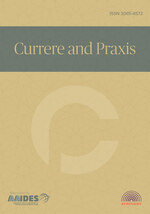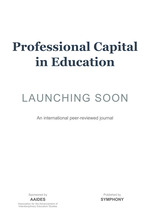Radial blended-collaboration in doctoral education: Insights from an Indonesian higher education institute
DOI:
https://doi.org/10.70116/2980274116Keywords:
Blended-collaboration, Doctoral-educator, EFL speaking, Instruction strategyAbstract
This study explored how doctoral educators apply a radial blended collaborative (RBC) strategy to teach EFL speaking. This study used a narrative case study design and a qualitative approach. In doing so, teachers employed eight RBCs' strategies: raising collaboration awareness, forming groups based on 21st-century skills, using controlled-chosen topics and theme-based prior knowledge, employing snowball questioning techniques, engaging in role-play in different contexts, conducting peer evaluations, and providing oral and written feedback. This study found that technology integration, such as WhatsApp, Zoom Meeting, Google Classroom, and electronic mail, enhanced the learning experience, whereas pooling WhatsApp messages was used to direct the chosen discussion topics. The results demonstrated that RBC significantly improved students' speaking performance across four instructional dimensions: collaborative awareness, active learning, classroom interaction, and technological integration. Future research should aim to enhance spoken communication by integrating technology in assessments and fostering collaborative learning environments.
Downloads
References
Ardiningtyas, S. Y., Butarbutar, R., Weda, S., & Nur, S. (2023). Online scaffolding behavior for speaking EFL improvement: narrative inquiry issues. Interactive Learning Environments, 1-11. https://doi.org/10.1080/10494820.2023.2207608
Baleghizadeh, S., & Nasrollahi Shahri, M. N. (2014). EFL teachers’ conceptions of speaking competence in English. Teachers and Teaching, 20(6), 738-754.
Berry, R. S. Y. (1999). Collecting data by in-depth interviewing. Proceeding of Research, British Educational Research Association Annual Conference (pp. 1-10), University of Sussex at Brighton. https://www.angelfire.com/nb/ba1199/lesson016/indepth.htm
Beth, A. D., Jordan, M. E., Schallert, D. L., Reed, J. H., & Kim, M. (2015). Responsibility and generativity in online learning communities. Interactive Learning Environments, 23(4), 471-484.
Borrie, S. A., McAuliffe, M. J., Liss, J. M., Kirk, C., O'Beirne, G. A., & Anderson, T. (2012). Familiarisation conditions and the mechanisms that underlie improved recognition of dysarthric speech. Language and Cognitive Processes, 27(7-8), 1039-1055
Bower, K. (2019). Explaining motivation in language learning: a framework for evaluation and research. The Language Learning Journal, 47(5), 558-574. https://doi.org/10.1080/09571736.2017.1321035
Braun, V., & Clarke, V. (2006). Using thematic analysis in psychology. Qualitative Research in Psychology, 3(2), 77–101. https://doi.org/10.1191/1478088706qp063oa
Bruffee, K. (1984). Collaborative learning and the “Conversation of Mankind.”College English, 46(7), 635-652. https://doi.org/10.2307/376924
Burns, A. (1998). Teaching speaking. Annual Review of Applied Linguistics, 18, 102-123. https://doi.org/10.1017/s0267190500003500
Butarbutar, R. (2019). The study impact of Whatsapp group on critical reading skill. Magistra: Jurnal Keguruan Dan Ilmu Pendidikan, 6(1), 045-051.
Butarbutar, R. (2021). Learner’s perception of task difficulties in technology-mediated task-based language teaching. Englisia: Journal of Language, Education, and Humanities, 9(1), 129-144.
Butarbutar, R., & Leba, S. M. R. (2023). Teachers’ perspectives on teaching EFL speaking virtually: A case study of COVID-19 pandemic survival. American Journal of Social Sciences and Humanities, 8(1), 46-54.
Butarbutar, R., Leba, S. M. R., & Sauhenda, A. F. (2022). The impact of video integrated with Bloom’s taxonomy on the improvement of English-speaking performance. JEES (Journal of English Educators Society), 7(2), 126-134.
Butarbutar, R., Ruing, F. H., Basri, N., Tuharea, V. U., & Radja Leba, S. M. (2023). Unpacking Online Collaborative Learning in Teaching EFL Speaking: Insights from Three Rural Area Case Studies. The Qualitative Report. https://doi.org/10.46743/2160-3715/2023.6165
Butarbutar, R., Weda, S., & Nur, S. (2023). Guided-blended collaborative learning in speaking class: Voices of non-native English teachers and students from eastern Indonesia. American Journal of Education and Learning, 8(1), 88–99. https://doi.org/10.55284/ajel.v8i1.890
Campbell, S., Greenwood, M., Prior, S., Shearer, T., Walkem, K., Young, S., ... & Walker, K. (2020). Purposive sampling: complex or simple? Research case examples. Journal of Research in Nursing, 25(8), 652-661.
Carter, R., & McCarthy, M. (1997). Exploring spoken English. Cambridge University Press.
Chan, S., & Yuen, M. (2014). Personal and environmental factors affecting teachers’ creativity-fostering practices in Hong Kong. Thinking Skills and Creativity, 12, 69-77. https://doi.org/10.1016/j.tsc.2014.02.003
Chen, Z., & Goh, C. (2011). Teaching oral English in higher education: Challenges to EFL teachers. Teaching in Higher Education, 16(3), 333-345.
Chien, C. W. (2018). Professional dialogue among elementary school English teachers in Taiwan: Current challenges and issues. Education, 46(2), 188-201.
Chiriac, E. H., & Granström, K. (2012). Teachers’ leadership and students’ experience of group work. Teachers and Teaching, 18(3), 345-363.
Chun, S. Y. (2014). EFL learners' beliefs about native and non-native English-speaking teachers: perceived strengths, weaknesses, and preferences. Journal of Multilingual and Multicultural Development, 35(6), 563-579.
Deutsch, M. (1949). A theory of co-operation and competition. Human Relations, 2(2), 129-152.
Dörnyei, Z., & Thurrell, S. (1991). Strategic competence and how to teach it. ELT Journal, 45, 16–23. https://doi.org/10.1093/elt/45.1.16
Dugas, D. (2017). Group dynamics and individual roles: A differentiated approach to social-emotional learning. The Clearing House: A Journal of Educational Strategies, Issues and Ideas, 90(2), 41-47.
Ebadijalal, M., & Yousofi, N. (2023). The impact of mobile-assisted peer feedback on EFL learners’ speaking performance and anxiety: Does language make a difference?. The Language Learning Journal, 51(1), 112-130.
Eggins, S., & Slade, D. (1997). Analysing casual conversation. Cassell.
Ekoç, A. (2021). Teaching speaking with works of art in a preparatory class at university. Innovation in Language Learning and Teaching, 15(5), 415-427.
Ellis, R. (1990). Instructed second language acquisition. Blackwell.
Ernst, G. (1994). "Talking circle": Conversation and negotiation in the ESL classroom. TESOL Quarterly, 28, 293-322. https://doi.org/10.2307/3587435
Gan, Z. (2013). Understanding English speaking difficulties: An investigation of two Chinese populations. Journal of Multilingual and Multicultural Development, 34(3), 231-248.
Ginja, T. G., & Chen, X. (2023). Exploring middle school teachers’ understanding of English immersion and their instructional practices in Xi’an, China. Educational Studies, 1-16. https://doi.org/10.1080/00131946.2023.2165925
Guest, G., Namey, E., & Mitchell, M. (2013). Collecting qualitative data: A field manual for applied research. Sage. https://doi.org/10.4135/9781506374680.n4
Hasyim, N., Arismunandar, Butarbutar, R., Ramli, A. M., & Malik Nur, I. D. (2024). Mind mapping of teachers’ readiness for online teaching and learning: A reflective study of urban and suburban areas. Cogent Education, 11(1). https://doi.org/10.1080/2331186x.2023.2292864
Hurd, P. D. (2000). Active learning. Journal of Pharmacy Teaching, 7(3), 29-47.
Husain, H., Bais, B., Hussain, A., & Samad, S. A. (2012). How to construct open ended questions. Procedia-Social and Behavioral Sciences, 60, 456-462. https://doi.org/10.1016/j.sbspro.2012.09.406
Hwang, W. Y., Guo, B. C., Hoang, A., Chang, C. C., & Wu, N. T. (2022). Facilitating authentic contextual EFL speaking and conversation with smart mechanisms and investigating its influence on learning achievements. Computer Assisted Language Learning, 1-27. https://doi.org/10.1080/09588221.2022.2095406
Jao, C. Y., Yeh, H. C., Huang, W. R., & Chen, N. S. (2022). Using video dubbing to foster college students’ English-speaking ability. Computer Assisted Language Learning, 1-23. https://doi.org/10.1080/09588221.2022.2049824
Johnson, D. W. (2003). Social interdependence: interrelationships among theory, research, and practice. American Psychologist, 58(11), 934. https://doi.org/10.1037/0003-066x.58.11.934
Johnson, D. W., & Johnson R. (1989). Cooperation and competition: Theory and research. Interaction Book Company.
Kalantari, R. (2009). Techniques for Classroom Interaction. International Journal of Language Studies (IJLS), 3(4), 425-434.
Kanika, Chakraverty, S., Chakraborty, P., & Madan, M. (2022). Effect of different grouping arrangements on students’ achievement and experience in collaborative learning environment. Interactive Learning Environments, 1-13. https://doi.org/10.1080/10494820.2022.2036764
Kramsch, C. (2000). Second language acquisition, applied linguistics, and the teaching of foreign languages. The Modern Language Journal, 84(3), 311-326. https://doi.org/10.1111/0026-7902.00071
Laal, M. (2013). Positive interdependence in collaborative learning. Procedia-Social and Behavioral Sciences, 93, 1433-1437. https://doi.org/10.1016/j.sbspro.2013.10.058
Ladousse, G. P. (1989). Role play: Resource books for teachers. Oxford University Press.
Lising, L. (2021). ‘Speak English!’: Social acceleration and language learning in the workplace. International Journal of Bilingual Education and Bilingualism, 1-14. https://doi.org/10.1080/13670050.2021.1955499
Malebese, M. E. L., & Tlali, M. F. (2020). Teaching of English first additional language in rural learning environments: a case for problem-based learning. International Journal of Inclusive Education, 24(14), 1540-1551.
McCroskey, J. C., & Richmond, V. P. (1990). Willingness to communicate: Differing cultural perspectives. Southern Journal of Communication, 56(1), 72-77.
Miles, M. B., & Huberman, A. M. (1994). Qualitative data analysis: An expanded sourcebook. Sage.
Morris, A. (2015). A practical introduction to in-depth interviewing. Sage.
Murphy, M. P. (2022). Evaluating Simultaneous Group Activities Through Self-and Peer-Assessment: Addressing the “Evaluation Challenge” in Active Learning. Journal of Political Science Education, 18(4), 511-522
Nunan, D. (1989). Designing tasks for the communicative classroom. Cambridge University Press.
Nur, S., & Butarbutar, R. (2022). Empowering EFL learner’s Self-efficacy through Collaborative task-based Instruction: A Critical Review. VELES: Voices of English Language Education Society, 6(1), 118-129.
Nur, S., Butarbutar, R., Ardiningtyas, S. Y., & Alimuddin, A. H. (2022). A systematic review on integrating MALL in English language teaching. ELT Worldwide, 9(1), 56-69.
Orfan, S. N. (2020). Afghan EFL students’ difficulties and strategies in learning and understanding English idioms. Cogent Arts & Humanities, 7(1), https://doi.org/10.1080/23311983.2020.1796228
Richards, J. C. (1990). The language teaching matrix. Cambridge University Press.
Rienties, B., Lewis, T., McFarlane, R., Nguyen, Q., & Toetenel, L. (2018). Analytics in online and offline language learning environments: The role of learning design to understand student online engagement. Computer Assisted Language Learning, 31(3), 273-293.
Savaşçı, M. (2014). Why are some students reluctant to use L2 in EFL speaking classes? An action research at tertiary level. Procedia-Social and Behavioral Sciences, 116, 2682-2686.
Siqin, T., & Chu, S. K. W. (2021). How students take collective responsibility for productive collaboration: An empirical examination of online discourse. Interactive Learning Environments, 29(7), 1076-1089.
Tellis, W. (1997). Introduction to case study. The Qualitative Report, 3(2), 1-14.
Timpe-Laughlin, V., Sydorenko, T., & Daurio, P. (2022). Using spoken dialogue technology for L2 speaking practice: What do teachers think?. Computer Assisted Language Learning, 35(5-6), 1194-1217.
Tremblay-Wragg, É., Raby, C., Ménard, L., & Plante, I. (2021). The use of diversified teaching strategies by four university teachers: What contribution to their students’ learning motivation? Teaching in Higher Education, 26(1), 97-114.
Tsegaye, M. T., Bleser, R. D., & Iribarren, C. (2011). The effect of literacy on oral language processing: Implications for aphasia tests. Clinical Linguistics & Phonetics, 25(6-7), 628-639.
Uztosun, M. S. (2020). The development of a scale for measuring the self-regulated motivation for improving speaking English as a foreign language. The Language Learning Journal, 48(2), 213-225.
Viberg, O., Mavroudi, A., Fernaeus, Y., Bogdan, C., & Laaksolahti, J. (2020). Reducing free riding: CLASS–a system for collaborative learning assessment. In Methodologies and Intelligent Systems for Technology Enhanced Learning, 9th International Conference, Workshops (pp. 132-138). Springer International Publishing. https://doi.org/10.1007/978-3-030-23884-1_17
Vygotsky, L. S. (1987). The collected works of LS Vygotsky: Problems of general psychology, including the volume thinking and speech. Springer Science & Business Media. https://doi.org/10.1007/978-1-4613-1655-8_7
Yang, N. D. (1998). Exploring a new role for teachers: Promoting learner autonomy. System, 26(1), 127-135.
Downloads
Published
How to Cite
Issue
Section
License
Copyright (c) 2024 Symphony

This work is licensed under a Creative Commons Attribution 4.0 International License.














